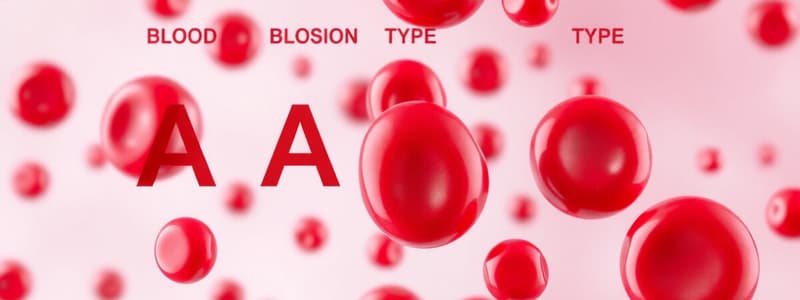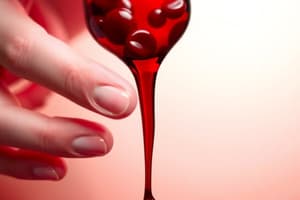Podcast
Questions and Answers
What is the primary function of the coronary vessels?
What is the primary function of the coronary vessels?
- To supply the heart with nutrients (correct)
- To regulate electrical activity in the heart
- To transport oxygenated blood to the lungs
- To pump blood out of the heart
What is the sequence of events during one heartbeat known as?
What is the sequence of events during one heartbeat known as?
- Cardiac rhythm
- Cardiac output
- Cardiac cycle (correct)
- Cardiac conduction
Which of the following describes systole?
Which of the following describes systole?
- The contraction phase of the heart (correct)
- The slipping of blood back into the heart
- The filling phase of the heart
- The phase of heart relaxation
What initiates the electrical impulses that generate the heartbeat?
What initiates the electrical impulses that generate the heartbeat?
What is indicated by the term 'fibrillation' in the context of heart rhythms?
What is indicated by the term 'fibrillation' in the context of heart rhythms?
What would happen if someone with type O blood received a blood transfusion with type A blood?
What would happen if someone with type O blood received a blood transfusion with type A blood?
In the context of blood types, what is the universal donor blood type?
In the context of blood types, what is the universal donor blood type?
What occurs when Rh-negative blood is first exposed to Rh-positive blood?
What occurs when Rh-negative blood is first exposed to Rh-positive blood?
Which chambers of the heart are separated by the interventricular septum?
Which chambers of the heart are separated by the interventricular septum?
How does Atrial Natriuretic Hormone (ANH) affect blood pressure?
How does Atrial Natriuretic Hormone (ANH) affect blood pressure?
What is the role of the pericardium surrounding the heart?
What is the role of the pericardium surrounding the heart?
What structure prevents backflow from the ventricles to the atria?
What structure prevents backflow from the ventricles to the atria?
What is the final destination of blood leaving the left ventricle?
What is the final destination of blood leaving the left ventricle?
What occurs if there is an obstruction in the coronary vessels?
What occurs if there is an obstruction in the coronary vessels?
Which phase of the cardiac cycle is characterized by the relaxation of the ventricles?
Which phase of the cardiac cycle is characterized by the relaxation of the ventricles?
During the cardiac conduction process, what is the role of the bundle of His?
During the cardiac conduction process, what is the role of the bundle of His?
What is indicated by the absence of a pulse in a patient experiencing fibrillation?
What is indicated by the absence of a pulse in a patient experiencing fibrillation?
What is the normal resting pulse rate as dictated by the sinoatrial (SA) node?
What is the normal resting pulse rate as dictated by the sinoatrial (SA) node?
What is the primary consequence of myocardial infarction?
What is the primary consequence of myocardial infarction?
Which structure is responsible for collecting blood from capillaries before returning it to the right atrium?
Which structure is responsible for collecting blood from capillaries before returning it to the right atrium?
Which term best describes the phenomenon of palpitations?
Which term best describes the phenomenon of palpitations?
Which type of blood vessels are responsible for supplying nutrients to the heart muscle?
Which type of blood vessels are responsible for supplying nutrients to the heart muscle?
What is the primary function of chordae tendineae in the heart?
What is the primary function of chordae tendineae in the heart?
What are the consequences of a wrong blood type transfusion?
What are the consequences of a wrong blood type transfusion?
Which blood type would produce antibodies if it receives Rh-positive blood?
Which blood type would produce antibodies if it receives Rh-positive blood?
What structure separates the atria and ventricles of the heart?
What structure separates the atria and ventricles of the heart?
Which chamber of the heart has the thickest walls?
Which chamber of the heart has the thickest walls?
What happens to blood volume when Atrial Natriuretic Hormone (ANH) is released?
What happens to blood volume when Atrial Natriuretic Hormone (ANH) is released?
What type of blood has no antigens for A and B, allowing it to be accepted by all blood types?
What type of blood has no antigens for A and B, allowing it to be accepted by all blood types?
Which vessel carries blood away from the right ventricle to the lungs?
Which vessel carries blood away from the right ventricle to the lungs?
What components are present in the pericardium surrounding the heart?
What components are present in the pericardium surrounding the heart?
What condition is likely to occur after a second transfusion of Rh-positive blood to an Rh-negative individual?
What condition is likely to occur after a second transfusion of Rh-positive blood to an Rh-negative individual?
Which of the following accurately describes the pathway of blood through the heart?
Which of the following accurately describes the pathway of blood through the heart?
Flashcards
Coronary Vessels
Coronary Vessels
Blood vessels that supply the heart muscle (myocardium) with nutrients.
Cardiac Cycle
Cardiac Cycle
Sequence of events during one heartbeat, involving contraction (systole) and relaxation (diastole) of heart chambers.
Cardiac Conduction
Cardiac Conduction
Electrical impulses that control the heart's contraction sequence.
Arrhythmias
Arrhythmias
Signup and view all the flashcards
Heart Rate
Heart Rate
Signup and view all the flashcards
Blood Type A
Blood Type A
Signup and view all the flashcards
Blood Type B
Blood Type B
Signup and view all the flashcards
Blood Type AB
Blood Type AB
Signup and view all the flashcards
Blood Type O
Blood Type O
Signup and view all the flashcards
Rh Positive
Rh Positive
Signup and view all the flashcards
Rh Negative
Rh Negative
Signup and view all the flashcards
Left Ventricle
Left Ventricle
Signup and view all the flashcards
Atrial Natriuretic Hormone (ANH)
Atrial Natriuretic Hormone (ANH)
Signup and view all the flashcards
Chordae Tendineae
Chordae Tendineae
Signup and view all the flashcards
Papillary Muscles
Papillary Muscles
Signup and view all the flashcards
Coronary Sinus
Coronary Sinus
Signup and view all the flashcards
Myocardium
Myocardium
Signup and view all the flashcards
Ischemia
Ischemia
Signup and view all the flashcards
Infarct
Infarct
Signup and view all the flashcards
Systole
Systole
Signup and view all the flashcards
Diastole
Diastole
Signup and view all the flashcards
SA Node
SA Node
Signup and view all the flashcards
Fibrillation
Fibrillation
Signup and view all the flashcards
ABO Blood Groups
ABO Blood Groups
Signup and view all the flashcards
Universal Donor
Universal Donor
Signup and view all the flashcards
Universal Recipient
Universal Recipient
Signup and view all the flashcards
Rh Factor
Rh Factor
Signup and view all the flashcards
Hemolysis
Hemolysis
Signup and view all the flashcards
Mediastinum
Mediastinum
Signup and view all the flashcards
Pericardium
Pericardium
Signup and view all the flashcards
Atrium vs. Ventricle
Atrium vs. Ventricle
Signup and view all the flashcards
Left Ventricle Function
Left Ventricle Function
Signup and view all the flashcards
Study Notes
Blood Types
- ABO Grouping:
- Type A blood has A antigens and antibodies to B antigens.
- Type B blood has B antigens and antibodies to A antigens.
- Type AB blood has both A and B antigens and no antibodies.
- Type O blood has neither A nor B antigens and antibodies to both A and B antigens.
- Transfusion Reactions: Incorrect blood type transfusions cause blood cell clumping and rupture, leading to kidney damage and renal failure.
- Universal Donor/Recipient: Type O is the universal donor, and type AB is the universal recipient.
- Type O negative is the universal donor and AB positive is universal recipient.
Rh Factor
- Rh Positive/Negative: Rh-positive blood has the Rh antigen; Rh-negative blood does not.
- Anti-Rh Antibody Production: If Rh-negative blood receives Rh-positive blood, the recipient's body produces antibodies against the Rh antigen.
- Transfusion Reactions (Rh): First Rh-positive transfusion to an Rh-negative recipient may not cause problems, but a second transfusion will cause a serious reaction with hemolysis (red blood cell destruction) and potential kidney damage.
Mediastinum and Pericardium
- Mediastinum: The central part of the thoracic cavity, containing the heart, great vessels, and esophagus.
- Pericardium: The membrane surrounding the heart, consisting of two layers:
- Fibrous pericardium (outer layer)
- Serous pericardium (inner layer, with parietal and visceral parts).
Chambers, Vessels, and Valves
- Heart Structure: The heart is a four-chambered pump of cardiac muscle (myocardium) and lined with the endocardium (smooth inner lining to prevent clotting).
- Atria/Ventricles: Upper chambers are atria; lower chambers are ventricles. Septa separate the atria and ventricles.
- Blood Pathway: Blood flows through the heart: Inferior/Superior vena cava -> Right atrium -> Tricuspid valve -> Right ventricle -> Pulmonary semilunar valve -> Pulmonary artery -> Lungs -> Pulmonary veins -> Left atrium -> Bicuspid valve -> Left ventricle -> Aortic semilunar valve -> Aorta -> Body
Atrial Natriuretic Hormone (ANH)
- Release Trigger: Atria release ANH when stretched by increased blood volume or pressure.
- Kidney Effect: ANH decreases sodium reabsorption in the kidneys.
- Overall Effect: Water follows sodium, reducing blood volume and blood pressure.
Left Ventricle
- Wall Thickness: Thicker walls compared to other chambers, allowing for more forceful contractions.
- Blood Flow: Blood is pumped into the aorta through the aortic semilunar valve. The valve has chordae tendineae and papillary muscles.
Coronary Vessels
- Origin: Branch from the ascending aorta.
- Distribution: Vessels branch into smaller arteries, arterioles, and capillaries to supply the myocardium (heart muscle) with nutrients.
- Blood Return: Coronary veins collect blood from the capillaries and deliver it to the coronary sinus, which returns blood to the right atrium.
- Ischemia/Infarct: Obstruction causes ischemia (decreased oxygen supply). Without restoring blood flow, the tissue dies (infarct).
Cardiac Cycle
- Description: The sequence of events during one heartbeat.
- Phases: Simultaneous contraction of the atria, followed by simultaneous contraction of the ventricles.
- Systole/Diastole: Systole is contraction; diastole is relaxation.
Cardiac Conduction
- Regulation: Mechanical heart actions are regulated by the heart's electrical activity.
- Spontaneity: Heart cells contract spontaneously.
- Pathway: Electrical impulses originate and spread through the: SA node -> AV node -> Atrial myocardium -> Bundle of His -> Bundle branches -> Purkinje fibers.
Arrhythmias
- Definition: Irregular heartbeats, ranging from harmless to life-threatening.
- Palpitations: Occasional, irregular heartbeats.
- Fibrillation: Rapid and uncoordinated ventricular contractions, ineffectively pumping blood (quivering ventricles = no pulse).
Heart Rate
- Normal Range (SA Node): 60-80 beats per minute at rest.
Studying That Suits You
Use AI to generate personalized quizzes and flashcards to suit your learning preferences.



